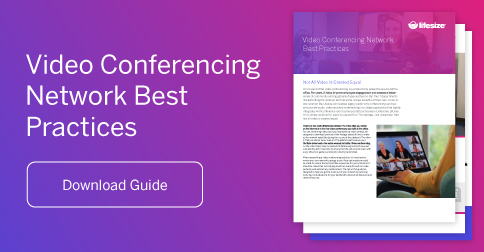
Optimizing Your Network Bandwidth for Video Conferencing
Calculate your video conferencing bandwidth requirement and learn how to optimize your network for video conferencing.
There are a couple of big differences between the video clips you watch on the internet and the live video conferences you hold at the office. For one, streaming video clips (your standard cat video variety) are designed to download portions of the footage ahead of time to make up for network instability during the course of the playback. The other is that you almost never raise an IT helpdesk ticket because your YouTube video took a few extra seconds to buffer. Video conferencing, on the other hand, relies on packets of data being sent and received consistently and in real time to ensure that the call remains clear, with every inflection, gesture and word correctly transmitted. When optimizing your network for video conferencing, it’s important to plan for an appropriate amount of bandwidth headroom.
Looking at Lifesize service usage data, a typical organization should account for at least 5 percent concurrent utilization, or five simultaneous calls for every 100 users sharing an internet connection. Organizations that use video conferencing significantly more can factor that in. It’s also important to build in an additional 10 percent of overhead to account for call signaling and packetization.
As for the individual call requirements, a point-to-point video call between two users or locations will use about 2 Mbps down and 2 Mbps up of internet bandwidth on both sides — since both groups are sending and receiving packets of data during a live call. These requirements are designed to make sure the call runs smoothly and with the best quality possible (or from IT’s perspective, to minimize the chance of a quality-related helpdesk ticket being submitted).
The Lifesize cloud architecture is built to rely as little on the public internet and as little on your bandwidth as possible. When you have Lifesize calls or meetings with participants located around the world, instead of traversing the entire distance on the public internet, the call is routed to the nearest IBM SoftLayer PoP (point of presence), where it jumps on their ultrafast, managed fiber network to navigate the globe. The call isn’t constantly hopping among different providers like it would on the public internet, which would increase latency and produce a much lower-quality call. The Lifesize and IBM Cloud relationship is designed to take the daily maintenance and connectivity reliability off of your IT team and give you the best possible video quality.
For more tips on optimizing your network, check out our guide of Video Network Best Practices. In it, we provide some tips for optimizing your network topology to route your video traffic as efficiently as possible and talk about the importance of providing a secure and solid foundation for reliable video calling.
Source: Optimizing Your Network Bandwidth for Video Conferencing


